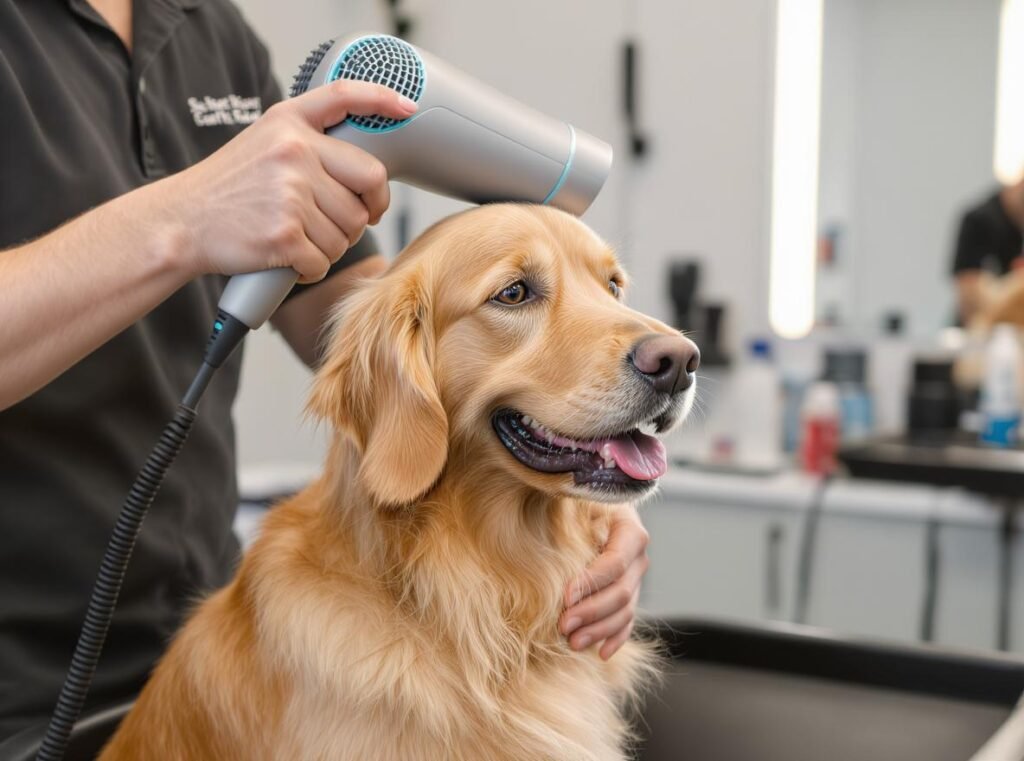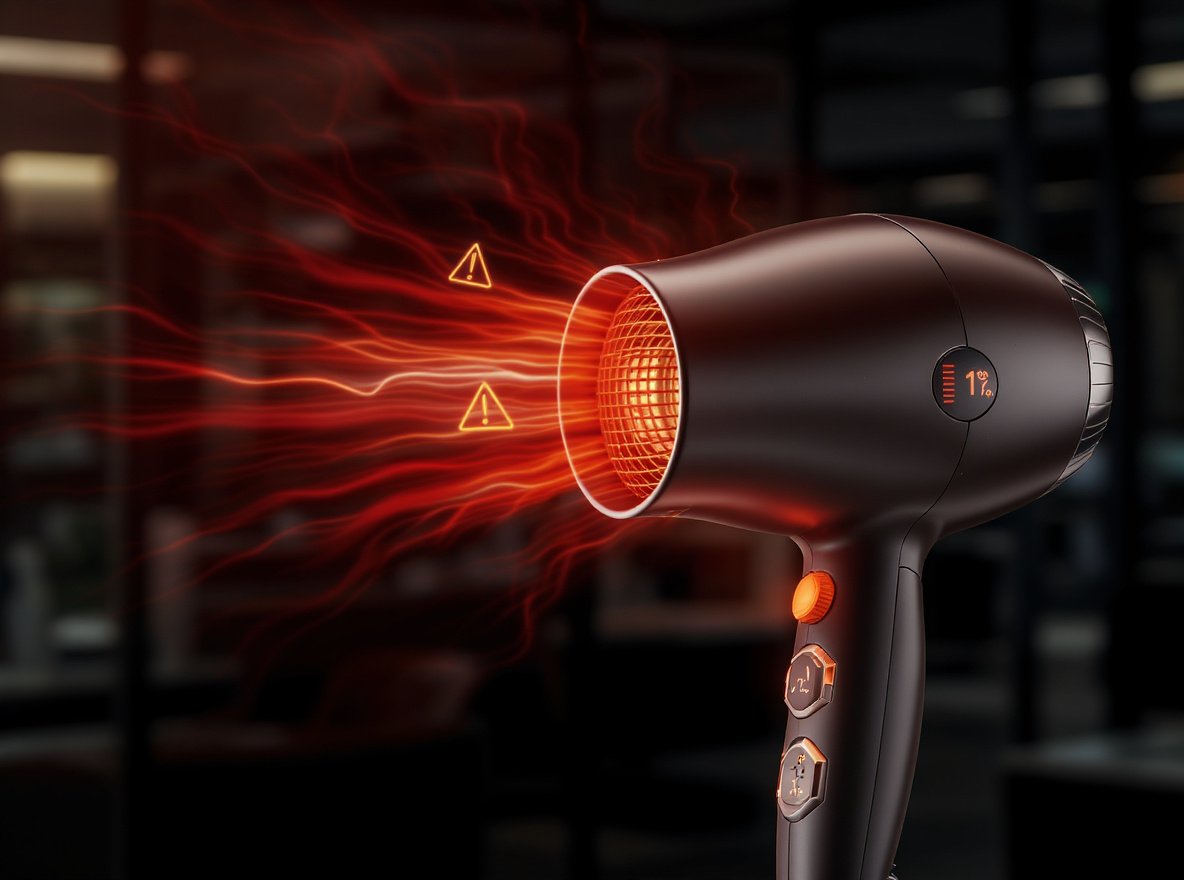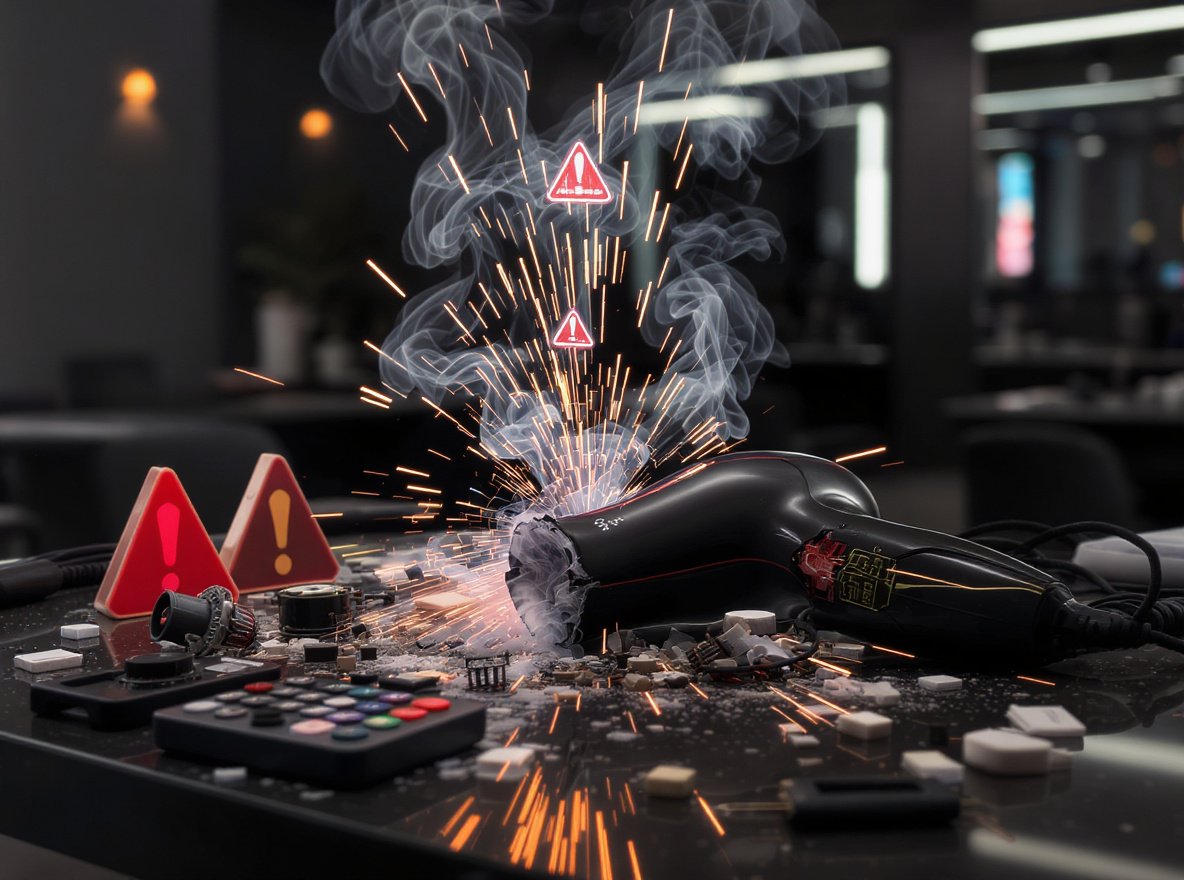Professional dog grooming demands precise temperature control and optimal airflow management to ensure pet safety while achieving efficient drying results. Many wholesale buyers struggle with understanding the technical specifications needed for safe, effective dog drying equipment.
The ideal temperature range for dog hair dryers is 35-57°C (95-135°F), significantly lower than human hair dryers. Professional models should offer airflow speeds from 20-72 m/s with variable controls. Dogs’ normal body temperature ranges from 100.5-102.5°F, making temperature regulation critical for preventing overheating and burns.
Understanding these specifications helps wholesale buyers select equipment that balances professional performance with comprehensive safety features for diverse grooming operations.
Table of Contents
ToggleWhat Temperature Range Ensures Safe Dog Hair Drying?
Temperature control represents the most critical safety factor in professional dog grooming equipment. Unlike human hair dryers, dog dryers must operate within much stricter temperature parameters to prevent injury and stress.
Professional dog hair dryers should operate between 35-57°C (95-135°F), significantly lower than human hair dryers. Dogs’ normal body temperature ranges from 100.5-102.5°F, making temperatures above 130°F dangerous and potentially causing burns or overheating. Always start with the lowest heat setting and gradually increase if necessary.
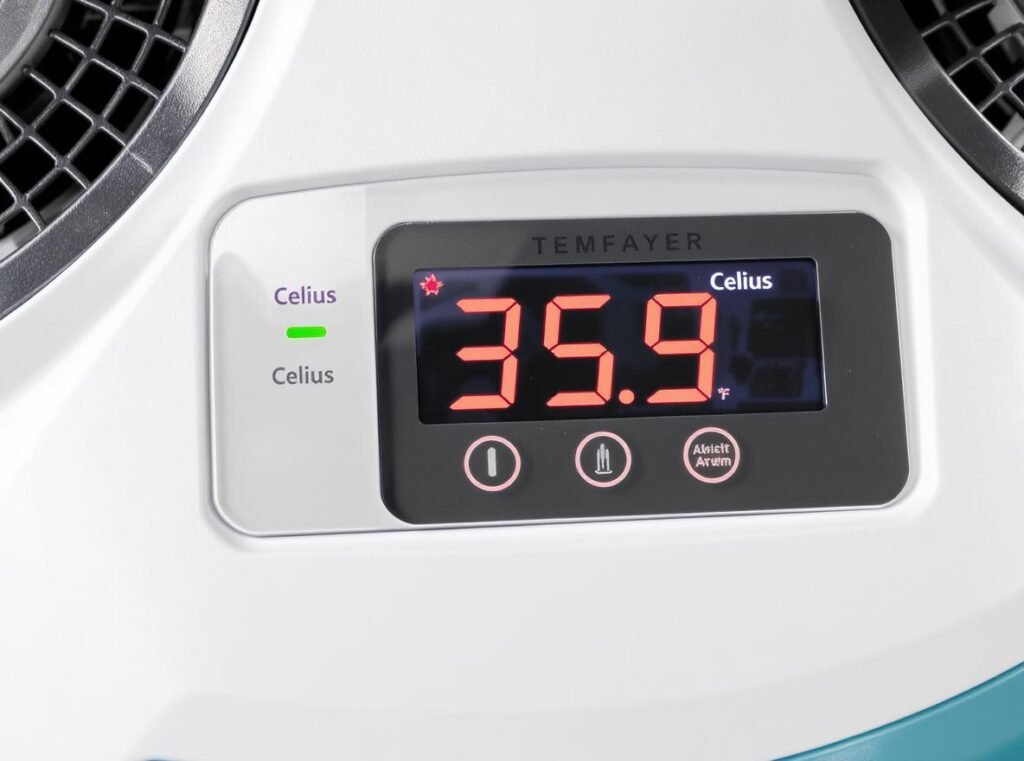
Professional groomers recommend specific temperature guidelines based on application and environment:
Temperature Settings by Application:
- Initial water removal: 35-40°C (95-104°F) with high airflow
- Body drying: 40-50°C (104-122°F) for efficient moisture elimination
- Finishing work: 30-35°C (86-95°F) for sensitive areas and final styling
Environmental Temperature Adjustments:
- Cold rooms (<18°C): Increase dryer temperature by 5-10°C to compensate
- Warm rooms (>25°C): Reduce heat settings or use cool air to prevent overheating
- High humidity conditions: Slightly higher temperatures aid evaporation efficiency
Professional dog dryers should feature precise digital temperature control within safe ranges, providing the exact temperature management professional groomers require for safe operation while maintaining drying efficiency across different coat types and environmental conditions.
Critical Safety Protocols:
- Never exceed 57°C (135°F) under any circumstances
- Test temperature on your hand before directing toward pets
- Monitor pets every 10-15 minutes during heated drying sessions
- Maintain continuous nozzle movement to prevent hot spot formation
How Do Professional Airflow Settings Impact Drying Efficiency?
Airflow velocity determines both drying speed and pet comfort levels. Professional equipment must offer variable speed controls to accommodate different coat types, pet sensitivities, and grooming applications effectively.
Professional dog dryers typically offer airflow speeds from 20-72 m/s, with some models producing over 58,000 feet-per-minute airflow. High-velocity drying relies on mechanical water removal rather than heat, making airflow more critical than temperature for efficient results.
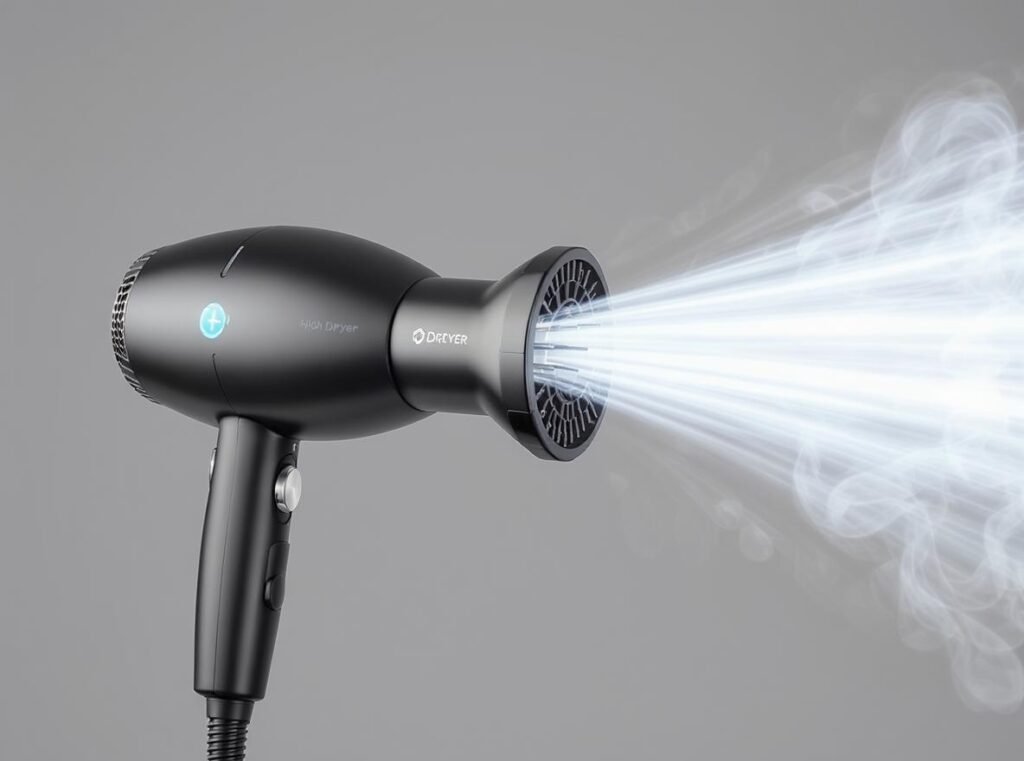
Airflow Speed Applications:
| Speed Setting | Velocity Range | Primary Use | Pet Comfort Level |
|---|---|---|---|
| Low Speed | 20-35 m/s | Face, ears, sensitive areas | Maximum comfort |
| Medium Speed | 35-50 m/s | Body drying, nervous pets | Good comfort |
| High Speed | 50-72 m/s | Thick coats, undercoat removal | Requires gradual introduction |
Mechanical Water Removal Principles:
High-velocity dryers work by literally blasting water off the coat rather than evaporating it through heat. This approach proves more efficient and safer than traditional heated drying methods.
Coat-Specific Airflow Requirements:
- Double-coated breeds: Maximum velocity (60-72 m/s) for undercoat penetration
- Single-coated breeds: Medium velocity (35-50 m/s) for gentle but effective drying
- Short coats: Variable speed starting high for water removal, finishing with lower speeds
- Sensitive pets: Gradual speed increases to build tolerance over multiple sessions
Professional models should offer stepless speed adjustment, providing precise control for optimal results across all coat types. This flexibility allows groomers to customize airflow based on individual pet needs and specific grooming requirements.
Efficiency Optimization Techniques:
- Start with maximum safe velocity for initial water blast-off
- Reduce speed progressively as coat approaches dryness
- Use appropriate nozzle attachments to concentrate or diffuse airflow
- Maintain consistent distance and movement patterns for even drying
What Essential Safety Features Should Professional Dog Dryers Include?
Professional-grade dog dryers must incorporate comprehensive safety systems to protect both pets and operators. These features differentiate commercial equipment from consumer models and ensure reliable, safe operation in professional environments.
Essential safety features include automatic shut-off, thermal protection, temperature monitoring, and noise reduction technology. Professional dryers can produce sound levels of 105-108 dBA, requiring noise dampening to maintain operation below 80 dB for safe exposure.
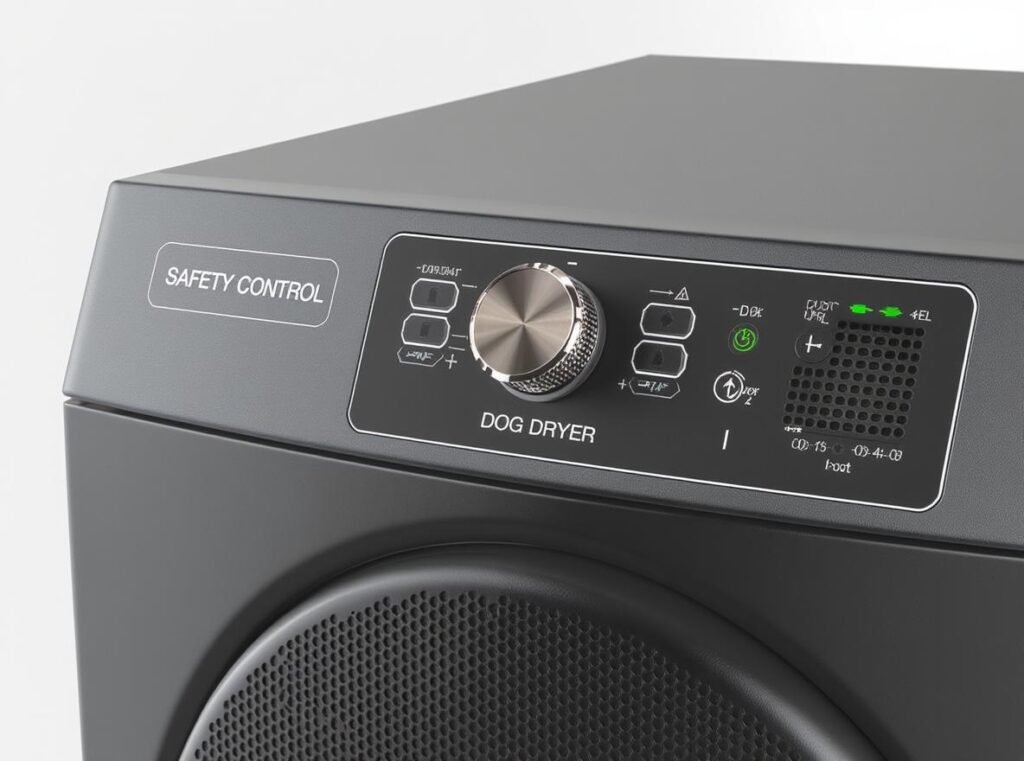
Critical Safety System Components:
Temperature Control Systems:
- Automatic temperature regulation maintains consistent heat output
- Thermal protection circuits prevent overheating during extended use
- Digital temperature displays provide real-time monitoring capabilities
- Overheat shutdown automatically stops operation if limits are exceeded
Noise Management Technology:
Professional dryers require significant noise reduction since standard models can exceed safe exposure limits for both groomers and pets. Quality equipment incorporates sound dampening to achieve 65-80 dB operation levels.
Airflow Safety Features:
- Variable speed controls with stepless adjustment for precise management
- Multiple nozzle attachments for different applications and safety requirements
- Pressure relief systems prevent excessive force buildup
- Automatic airflow balancing maintains consistent performance
Operational Safety Protocols:
- Timer controls with 1-99 minute settings prevent overexposure
- Emergency stop functions for immediate shutdown capability
- Ground fault protection ensures electrical safety in wet environments
- Heat-resistant housing prevents accidental burns during operation
Quality professional dog dryers integrate all these safety features with commercial-grade reliability. Comprehensive protection systems should include thermal management, noise reduction, and precise control capabilities that meet commercial grooming facility requirements.
Professional Compliance Standards:
- Meets international safety certifications for commercial use
- Incorporates redundant safety systems for maximum protection
- Features professional-grade components rated for extended operation
- Includes comprehensive operation and safety documentation
How Do Environmental Factors Affect Optimal Dryer Settings?
Environmental conditions significantly impact dryer performance and safety requirements. Professional groomers must understand how ambient temperature, humidity, and air circulation affect optimal equipment settings and drying efficiency.
Relative humidity, temperature, and air movement are the three primary factors determining drying speed. Most dehumidification equipment works best at temperatures between 70-90°F, making environmental control crucial for optimal grooming facility operation.

Environmental Impact Analysis:
| Environmental Factor | Impact on Drying | Required Adjustment | Efficiency Change |
|---|---|---|---|
| High Humidity (>70%) | Slows evaporation | Increase airflow 10-20% | +25% drying time |
| Low Humidity (<30%) | Accelerates drying | Reduce heat 5°C | -15% drying time |
| Cold Room (<18°C) | Reduces efficiency | Increase temperature 10°C | Standard time |
| Warm Room (>25°C) | Risk of overheating | Decrease heat, increase airflow | -10% drying time |
Temperature Calculation Principles:
Professional dryers add heat to existing ambient air. If salon temperature is 20°C and the dryer adds 20°C, output reaches 40°C. This relationship requires constant adjustment based on environmental conditions.
Humidity Management Strategies:
High humidity dramatically slows evaporation rates, while low humidity accelerates the process. Professional facilities should maintain proper ventilation and humidity control systems to optimize drying conditions consistently.
Seasonal Adjustments Required:
- Winter operations: Higher temperatures compensate for cold ambient conditions
- Summer grooming: Increased airflow with reduced heat prevents overheating
- Rainy seasons: Extended drying times due to elevated humidity levels
- Dry climates: Gentler settings prevent skin irritation from low humidity
Air Circulation Requirements:
Poor ventilation traps heated air and moisture, creating dangerous conditions. Proper exhaust systems and air circulation help maintain safe temperatures while reducing overall drying times.
Professional Facility Optimization:
- Install dehumidification systems for consistent humidity control
- Maintain salon temperatures between 70-80°F for optimal equipment performance
- Implement proper ventilation to prevent heat and moisture buildup
- Monitor environmental conditions regularly for consistent results
What Are the Best Practices for Different Dog Coat Types?
Different coat types require specific temperature and airflow combinations to achieve optimal results safely. Understanding these variations helps wholesale buyers select versatile equipment that handles diverse grooming requirements efficiently.
Different coat types require specific approaches: double-coated breeds need high-velocity techniques with moderate heat, while single-coated dogs require gentler settings. Begin with towel drying to remove excess moisture, then use high-velocity drying to penetrate dense undercoats.
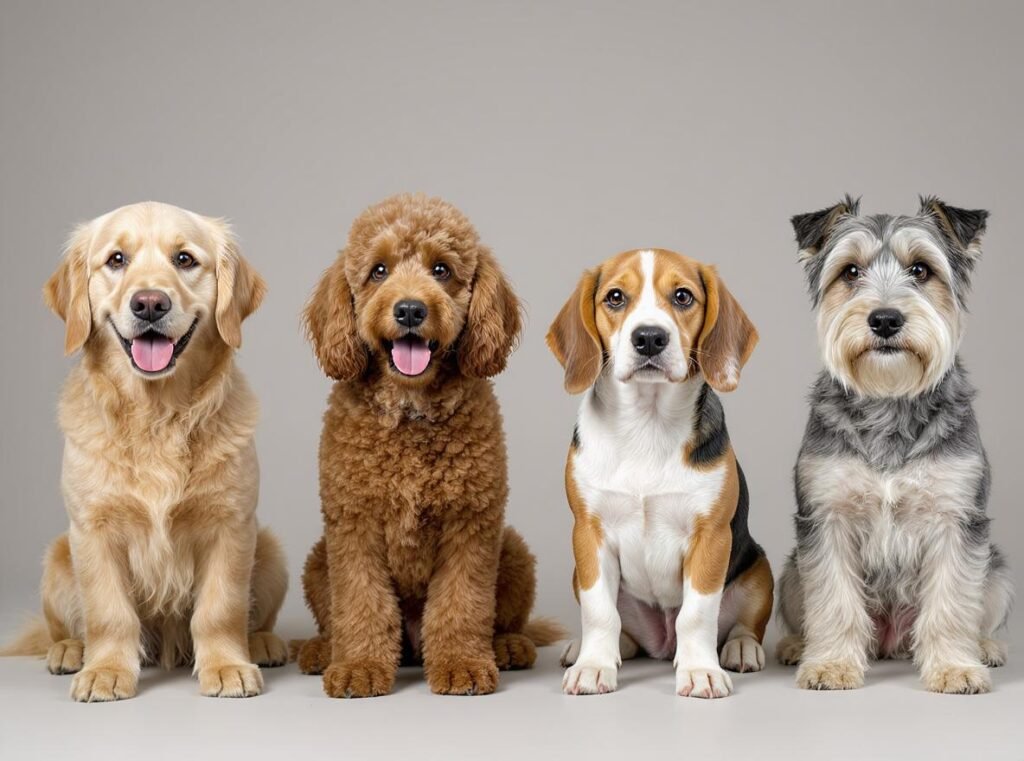
Double-Coated Breed Techniques (Huskies, Golden Retrievers, Samoyeds):
Double-coated dogs require specialized approaches to penetrate dense undercoats effectively while removing loose fur.
- Temperature range: 40-50°C (104-122°F) for optimal penetration
- Airflow velocity: Maximum safe speed (60-72 m/s) for undercoat blast-out
- Technique sequence: High-velocity water removal, section-by-section undercoat work, finishing with lower speeds
- Nozzle selection: Round nozzles for initial removal, rectangular for finishing
Single-Coated Breed Management (Poodles, Maltese):
These breeds require gentle handling to prevent coat damage while achieving thorough drying.
- Temperature settings: 35-45°C (95-113°F) for safe, effective drying
- Airflow control: Medium velocity (35-50 m/s) prevents coat breakage
- Direction technique: Follow natural hair growth patterns
- Special considerations: Use stretch-drying with light brushing for straightening
Short-Coated Dog Protocols (Beagles, Boxers):
Short coats dry quickly but require careful distance management to prevent skin burns.
- Nozzle positioning: Maintain 1cm from skin with continuous movement
- Movement patterns: Use short, sharp strokes preventing heat concentration
- Temperature control: 35-40°C (95-104°F) maximum for skin safety
- Efficiency techniques: Quick, systematic coverage with rubber grooming tools
Specialized Coat Considerations:
Wire-Haired Breeds (Terriers):
- Lower temperatures (30-35°C) preserve coat texture
- Medium-high velocity maintains wire coat characteristics
- Simultaneous brushing during drying enhances texture
Curly and Coily Coats:
- Minimal heat settings prevent frizz formation
- Low airflow speeds maintain curl definition
- Never use cage drying as it causes unwanted wave patterns
Quality professional dog dryers with variable control systems are ideal for handling multiple coat types efficiently. Commercial-grade motors deliver consistent performance across all settings while maintaining precise temperature and airflow control.
How Can Proper Settings Reduce Drying Time and Improve Professional Results?
Efficient drying techniques directly impact business productivity and customer satisfaction. Understanding the relationship between optimal settings and results helps maximize equipment investment returns while maintaining professional standards.
Optimal settings can reduce drying time by 30-40% while improving coat quality. A squeaky-clean coat dries faster than one with residual dirt or excessive conditioner. Start with high-velocity blasting for water removal, followed by focused section-by-section drying.
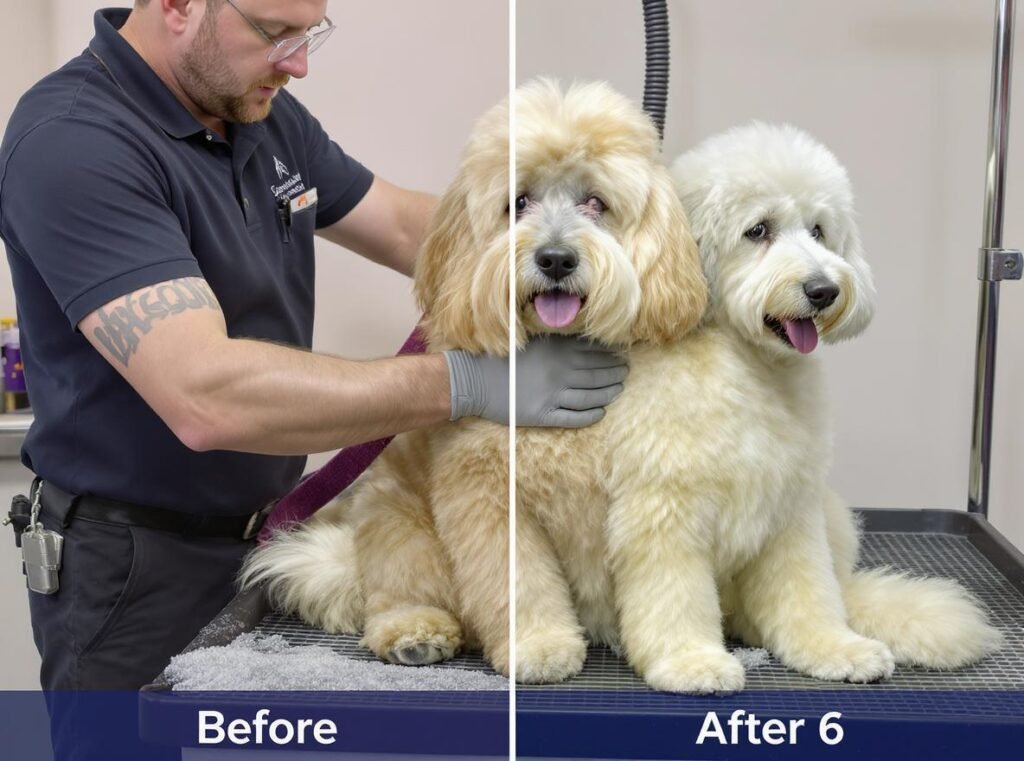
Pre-Drying Optimization Strategies:
Proper preparation significantly impacts overall efficiency and results quality.
Preparation Sequence:
- Thorough towel drying removes 60-70% of surface water immediately
- Squeaky-clean washing eliminates products that slow drying
- Excess water removal using squeegee tools on smooth coats
- Strategic positioning for optimal dryer access to all areas
Progressive Drying Methodology:
Professional techniques involve systematic approaches that maximize efficiency while maintaining safety.
Three-Stage Process:
- Stage 1: High-velocity water blast (70-72 m/s) for surface water removal
- Stage 2: Medium-velocity penetration (40-50 m/s) for thorough drying
- Stage 3: Low-velocity finishing (20-30 m/s) for styling and fluffing
Equipment Optimization Techniques:
- Nozzle selection: Round attachments for initial blast-out, rectangular for detailed work
- Distance management: Closer positioning for water removal, increased distance for finishing
- Pattern development: Systematic coverage prevents missed areas and reduces total time
Business Efficiency Measurements:
| Dog Size Category | Standard Time | Optimized Time | Efficiency Gain |
|---|---|---|---|
| Small (under 25 lbs) | 45 minutes | 30 minutes | 33% improvement |
| Medium (25-60 lbs) | 75 minutes | 50 minutes | 33% improvement |
| Large (over 60 lbs) | 120 minutes | 80 minutes | 33% improvement |
Professional Quality Standards:
- Complete dryness to skin level throughout entire coat
- Natural texture and volume restoration
- No remaining moisture in dense undercoat areas
- Smooth, professional finish meeting client expectations
Professional-grade dog dryers with powerful motors maintain consistent performance throughout extended grooming sessions, ensuring predictable results and minimizing equipment downtime that affects business productivity.
Advanced Efficiency Techniques:
- Spray conditioner integration during drying forces moisture-balancing products into coat
- Environmental optimization maintains ideal salon conditions for faster evaporation
- Progressive temperature adjustment starts warm for efficiency, cools for finishing comfort
What Critical Mistakes Must Be Avoided When Setting Dryer Parameters?
Understanding common errors helps prevent equipment damage, pet injury, and poor grooming results. Professional education on proper techniques protects business investments, animal welfare, and professional reputation.
Common mistakes include using human hair dryers, starting with high heat settings, maintaining static positioning, and inadequate supervision during cage drying. Never leave pets unattended with heated dryers operating, and check pets every 10-15 minutes during the drying process.
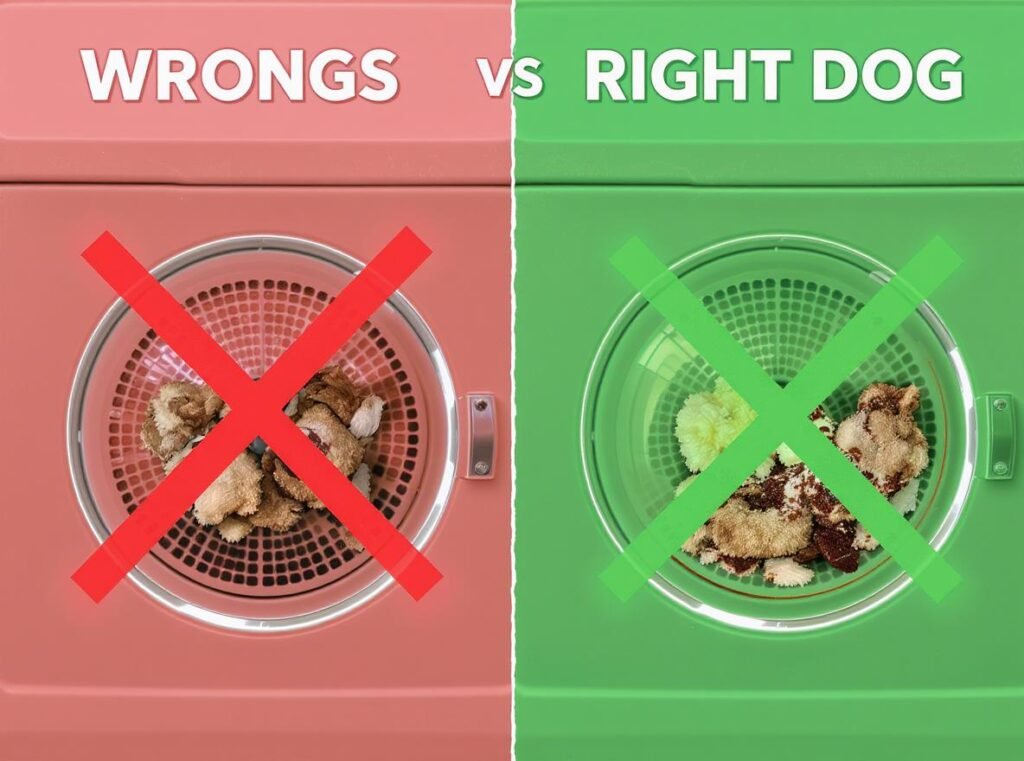
Dangerous Equipment Misuse:
Using Human Hair Dryers:
Human hair dryers reach temperatures too hot for dog skin and fur, creating serious burn risks. Always use pet-specific dryers designed for animal grooming applications.
Improper Heat Management:
- Never start with high heat settings – always begin with lowest temperatures
- Avoid exceeding 57°C (135°F) under any circumstances
- Ignore ambient temperature effects leading to overheating in warm environments
- Use adult settings for puppies or senior dogs with sensitive skin
Positioning and Movement Errors:
Static positioning causes dangerous hot spot formation that can burn skin within seconds.
Critical Distance and Movement Rules:
- Maintain minimum 6 inches from pet’s skin at all times
- Keep dryer constantly moving to prevent heat concentration
- Never direct heated air into enclosed spaces like cages or carriers
- Avoid concentrated airflow on sensitive areas without appropriate nozzle attachments
Supervision and Safety Protocol Violations:
Cage Drying Safety Violations:
Stand dryers producing 130°F+ air should never be directed into enclosed cages, creating oven-like conditions causing rapid overheating or burns.
Inadequate Monitoring Protocols:
- Never leave pets unattended with any heated dryer operating
- Check pets every 10-15 minutes for signs of distress or overheating
- Ignore pet stress signals including excessive panting, drooling, or agitation
- Skip safety feature verification before each use
Professional Training Requirements:
Staff Education Focus Areas:
- Proper equipment setup and calibration procedures
- Pet behavior recognition and emergency response protocols
- Equipment maintenance schedules and safety inspections
- Environmental factor adjustments for optimal performance
Noise Exposure Management:
Professional dryers can exceed safe noise exposure limits (105-108 dBA), requiring protective measures for both staff and pets during extended use.
Equipment Maintenance Oversights:
- Dirty filters reducing efficiency and causing overheating
- Worn nozzles affecting airflow patterns and safety
- Loose electrical connections creating potential hazards
- Inadequate cleaning protocols between different pets
Professional dog dryers should include comprehensive operation manuals and safety guidelines to prevent these common mistakes while supporting proper usage techniques that maximize both safety and efficiency.
Emergency Response Protocols:
- Immediate shutdown procedures for any signs of pet distress
- Overheating recognition and appropriate response measures
- Equipment malfunction procedures and backup system protocols
- Professional veterinary contacts for emergency situations
Summary
Professional dog hair dryers require precise temperature control between 35-57°C (95-135°F) and variable airflow settings from 20-72 m/s to ensure safe, efficient drying results. Understanding coat-specific requirements, environmental factors, and critical safety protocols enables wholesale buyers to select equipment that meets professional grooming standards while protecting animal welfare.
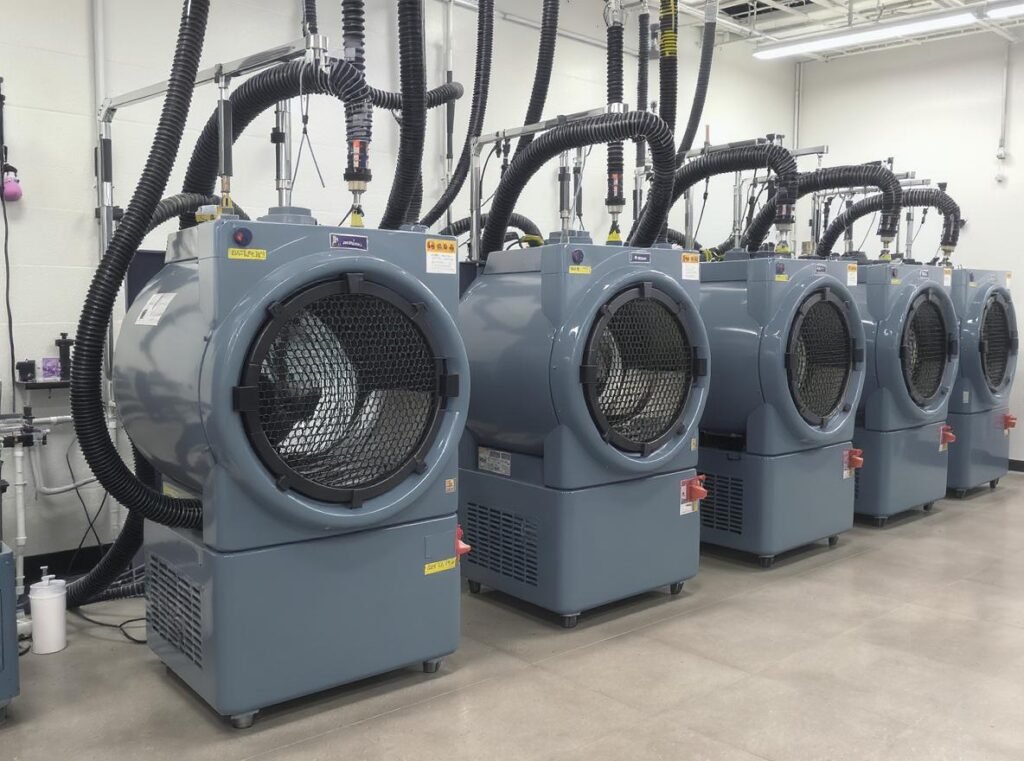
For wholesale buyers seeking reliable, professional-grade dog dryers with comprehensive safety features, explore our complete collection at https://conason.com/product/. Our professional dog drying equipment incorporates all the technical specifications and safety features discussed in this guide, making them excellent choices for professional grooming operations. Contact us today to discuss wholesale pricing and technical specifications tailored to your business requirements.

